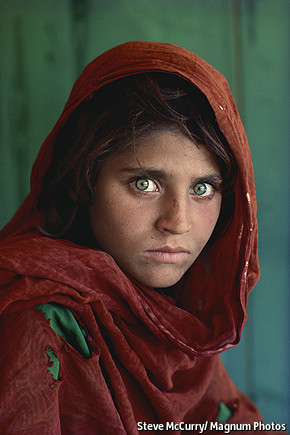One of the most well known pictures of all time which sold millions of copies of the National Geographic magazine and not just in the week it came up. The picture became part of the magazine's reputation. It also became a symbol of the damages inflicted to the most vulnerable refugees war: children.
Much has been done and written about the search for the unknown Afghan girl since she was found again 17 years after the original picture was taken. The Economist this week, refreshes our memory with a short Q&A with the photographer. Below an excerpt.
_________
Why did you think Sharbat Gula, the "Afghan Girl", was so special? Did you have any idea that the photograph would become so iconic?
I knew it was a powerful image. I knew that she had a powerful presence. She was very striking. I knew all that, but I never dreamed it would be on the cover of the magazine, much less become an icon of the [Soviet] war in Afghanistan or Afghan refugees. The power of the picture has to do with her eyes and the ambiguity of her expression. There are a lot of emotions in that picture; on the one hand she seems a bit traumatised, but there’s a real sense of dignity and fortitude and perseverance. She’s a beautiful little girl, but there is also dirt on her face and her clothes are torn, yet she holds a direct gaze at the camera.
How was your reunion 17 years later?
It was extraordinary. It was astonishing that she and her husband agreed to meet with us, which was really unusual in that culture. We were thrilled that she was still alive, that she had a good life, that we were able to finally give back to her and help her. I think she was a bit bewildered by the whole thing initially. She didn’t understand that her picture has been published all over the world. But in time she learned—we provided her with a television so she could see the documentary [“Search For the Afghan Girl” (2003)].
We keep in touch with her every month—myself, National Geographic, my sister plays a very important role in maintaining this relationship and assisting her with all sorts, whether it’s medical assistance, education, housing or anything we can do. We’ve helped to buy her a home that she’s able to have ownership of. It’s been great to help her. I believe that this has made her life better.

Sem comentários:
Enviar um comentário